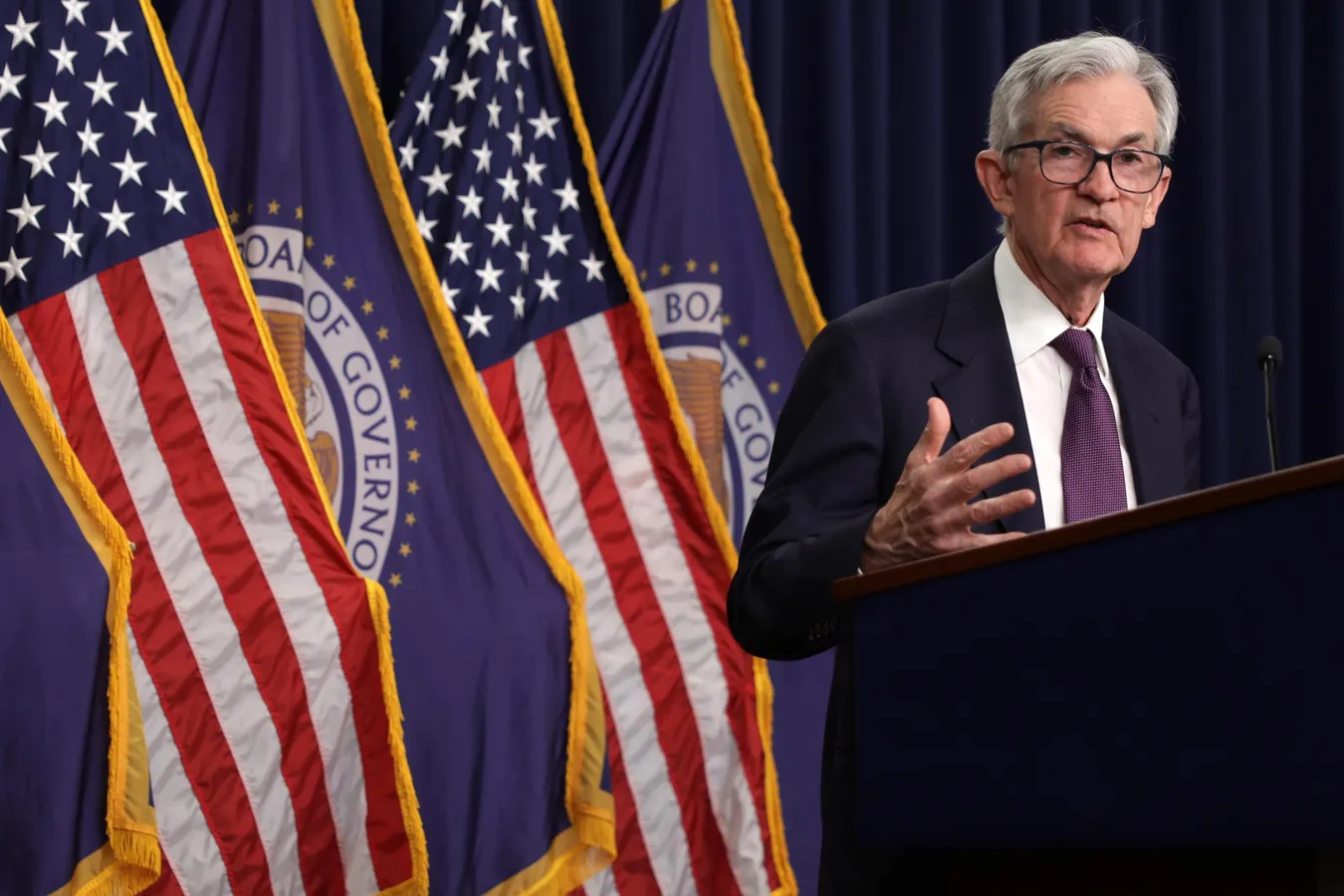By Chip Somodevilla,Contributor,Jeff Gapusan
Copyright forbes

Federal Reserve Board Chairman Jerome Powell speaks during a press conference following a meeting of the Federal Open Market Committee at the Federal Reserve on December 18, 2024 in Washington, DC., cutting the benchmark rate by a quarter percentage point to a range of 4.25% to 4.5%. (Photo by Alex Wong/Getty Images)
Getty Images
The Federal ReserveŌĆÖs Federal Open Markets Committee (FOMC) will conclude itŌĆÖs two-day meeting today, with a widely anticipated quarter-point interest rate cut, its first interest rate cut since December 2024, but the real story isn’t just about the cut itself. It’s about a looming question: could the last two years of monetary policy have been built on a faulty foundation?
Market participants rely on the FedŌĆÖs economic projections and signals for future rate changes driven by its dual mandate: to achieve maximum employment and stable prices. TodayŌĆÖs decision comes after a series of increasingly weak economic reports, particularly a lackluster August jobs report and back-month revisions from the Bureau of Labor Statistics that have called into question the reliability of data being used to report its monthly Non Farms Payroll report.
Likewise, Federal Reserve statements point to the challenge of navigating conflicting signals surrounding Trump administration tariff and trade policies. While its primary mission is to manage the domestic economy, it cannot ignore the global ramifications of measures.
On one hand, pundits have postulated about an inflationary effect as businesses pass on the higher costs to consumers. On the other, the resulting supply chain disruptions and general trade uncertainty can dampen global economic growth and spook businesses into delaying investment and hiring decisions.
This creates a difficult dilemma for the Fed: does it prioritize cutting rates to stimulate a weakening economy or does it hold firm to combat the potential for tariff-driven inflation?
MORE FOR YOU
Tariffs, Trade, And The Tug-Of-War On Prices
U.S. President Donald Trump holds up a chart while speaking during a ŌĆ£Make America Wealthy AgainŌĆØ trade announcement event in the Rose Garden at the White House on April 2, 2025 in Washington, DC. Touting the event as ŌĆ£Liberation DayŌĆØ. (Photo by Chip Somodevilla/Getty Images)
Getty Images
While the Nonfarm Payrolls number has historically been the star of the economic data show, the FedŌĆÖs decision today is also being influenced by the specter of tariff and trade data. The imposition of new tariffs on a wide range of imported goods has created a tug-of-war on prices.
On one hand, tariffs are designed to raise the cost of imports, which can have an inflationary effect if businesses pass those costs on to consumers. The latest BLSŌĆÖ Producer Price Index report showed a month-on-month decrease of 0.1% in August and an annualized 2.6% increase in the index for producers. Together, the data indicates a cooling of producer prices, not a decrease.
U.S. tariff and trade policy have created uncertainty around supply chains with heavy exposure to foreign trade counterparts, including automobile manufacturers.
Getty Images
On the other hand, the tariffs have also created supply chain uncertainty and dampened global economic activity, which can lead to a slowdown in growth and demand.
For the Fed, this presents a difficult dilemma: does it prioritize fighting potential tariff-driven inflation by holding rates, or does it cut rates to stimulate a weakening economy that is already feeling the pinch of trade tensions?
Market consensus is that the slowdown in the labor market is the more immediate concern, making the case for a rate cut more compelling, but the inflationary potential of tariffs remains a key factor in the Fed’s ongoing deliberations.
The Unreliable Snapshot: Revisions From 2023-2025
The monthly Nonfarm Payrolls number is not a final figure but a preliminary estimate, subject to significant revisions, which market participants heavily rely on to make investment and operating decisions.
The most dramatic of these are the annual benchmark revisions, which align the monthly survey data with the more comprehensive Quarterly Census of Employment and Wages (QCEW), a near-complete count of jobs derived from unemployment insurance tax records. The revisions for the period from 2023 to 2025 have been particularly striking.
In late 2024, the BLS announced a preliminary benchmark revision that lowered the job count by over 800,000 for the year ending in March 2024. The downward trend continued, and by September 2025, a subsequent preliminary revision indicated that the employment level in March 2025 was over 900,000 jobs lower than previously reported. Cumulatively, the downward revisions for the two-year period from March 2023 to March 2025 totaled a staggering 1.7 million jobs.
BLS Commissioner Erika McEntarfer was fired following larger then average back-month revisions to Non-Farm Payrolls reports over the past year. Part of an email to Bureau of Labor Statistics employees from William Wiatrowski, obtained by The Associated Press, is photographed Tuesday, Aug. 12, 2025. (AP Photo/Jon Elswick)
Copyright 2025 The Associated Press. All rights reserved.
These revisions reveal a stark truth: the labor market was not as robust as the monthly reports suggested. For the Fed, which was raising interest rates in 2023 and 2024, this meant that policy decisions may have been based on an overstated view of economic strength. Had the policymakers been operating with the more accurate QCEW data, they might have pursued a more dovish path, potentially avoiding some of the recent labor market weakness and the anxiety around today’s Federal Funds rate decision.
The his flawed premise shaped the backdrop around which the FOMC Fed’s aggressively campaigned to fight inflation over the past three years. The central bank’s primary justification for its historically rapid series of interest rate hikes ŌĆō 11 rate hikes between 2022-2023ŌĆō was the persistence of a tight labor market.
While BLS data at the time consistently showed robust job creation, suggesting that the economy could withstand the pressure of higher rates. The release of the BureauŌĆÖs Quarterly Census of Employment and Wages (QCEW) last week have now revealed that view of a booming labor market was likely an illusion created by faulty survey data.
The Changing Workforce
While it would be easy to simply place the blame on faulty data collection, itŌĆÖs necessary to investigate the changing face of the United StatesŌĆÖ workforce. The growth in public sector employment and the shifting dynamic from full-time to contract work in the private sector are two driving forces.
Private Vs. Public Sector Employment
The distinction between private and public sector employment has become increasingly relevant to the overall jobs narrative. While the overall proportion of the workforce in the public sector (around 13-15% of the total workforce) has not seen a dramatic shift, its contribution to job growth has.
According to the BLS’ June 2025 NFP report, nearly half of nearly half of all job growth in the US came from the public sector, including state and local government and public health.
Getty Images
Since early 2023, more than one in five new jobs created in the U.S. have been in the public sector, primarily in state and local government and public education, marking a significant change from the pre-pandemic decade when private-sector job creation was the dominant engine of employment growth. This rare role reversal (not seen since the Great Recession) has led to a significant portionŌĆösometimes nearly halfŌĆöof all job growth as shown in the BLS’ June 2025 report.
Meanwhile, the private sector seems to be in a “slow hiring, slow firing” environment, This trend is particularly important trend for the Federal Reserve, as it suggests that the private sector’s underlying strength may be weaker than any headline jobs number would indicate.
W-2 Vs. 1099 Employment
The shift from traditional W-2 employment to independent contracting (1099 work) in another notable trend, particularly since the pandemic accelerated the demand for flexible work arrangements.
By 2023, independent contractors, freelancers, and other gig workers constituted a significant portion of the workforce, with some estimates placing the number at over 60 million Americans, or roughly 36% of the workforce.
Close-up of sign at entrance to Silicon Valley headquarters of outsourcing and freelancing company Upwork, Mountain View, California. (Photo by Smith Collection/Gado/Getty Images)
Getty Images
By 2027, freelancers could make up over 50% of the U.S. workforce. While this isn’t a direct shift for every individual, it shows the proportion of gig work is increasing dramatically.
The data also suggests that many workers arenŌĆÖt making a complete move from W-2 to 1099. Instead, a growing number of individuals are combining traditional employment with gig work, often for supplemental income or to gain skills. This trend of a “blended” workforce is a key feature of the modern labor market.
Building A Real-Time, Tech-Driven Workforce Census
The reliance on survey data, while historically necessary, introduces a lag and a margin of error that has shown profound consequences. Modern workforce trends illustrate how ill-equipped the current system is to capture the rapid changes in the modern labor market.
The BLS’ reliance on survey data, while historically necessary, introduces a lag and a margin of error that has shown profound consequences for the accurate calculation of NFP numbers that could affect monetary policy.
The rise of the freelance economy and the shifting dynamics of public versus private sector employment point to needed changes to the future of economic reporting. Evolving technology provides the tools for a paradigm shift that replaces antiquated survey methods with real-time data analytics and AI.
New systems could leverage technology to create a more accurate and immediate census of the U.S. workforce. The tools exist today.
API-Based Payroll Integration
While incumbent companies like ADP and Paychex have processed a vast majority of U.S. payrolls, the growth of private companies (typically small businesses) demanding lightweight payroll solutions that can handle blended workforces has prompted the development of software packages like Intuit Quickbooks, Gusto and Truework.
Intuit Quickbooks and other lightweight software programs allow small business owners to process payrolls, an industry formerly owned by the likes of ADP and Paychex. Photographer: Tiffany Hagler-Geard/Bloomberg
┬® 2021 Bloomberg Finance LP
These newcomers rely on the strength of their APIs and the ability to share data that fuels financial outcomes for companies and employees alike. By establishing secure, aggregated data-sharing APIs with the BLS, payroll processors could provide a near-instantaneous and comprehensive view of both W-2 and 1099 employment.
By potentially eliminating the sampling error inherent in the Establishment Survey, this could provide a more accurate picture of the workforce, including the millions of gig economy workers whose data is often missed.
AI And Machine Learning For Market Intelligence
AI could be used to continuously scrape and analyze vast amounts of labor market data in real-time. This includes parsing public-sector budgets to predict hiring trends in government, analyzing job postings on platforms like LinkedIn and Indeed to forecast future demand, and even tracking sentiment on professional networks to gauge worker confidence and potential attrition. This would provide a forward-looking, predictive layer that traditional surveys simply cannot.
Artificial Intelligence and Mmachine learning could power more accurate data analysis to guide future NFP estimates. (Photo by KIRILL KUDRYAVTSEV/AFP via Getty Images)
AFP via Getty Images
Government Data Integration
The BLS could work more closely with other federal and state agencies to integrate data streams. For instance, combining data from the IRS on 1099 filings with state unemployment insurance records and Census Bureau data would provide a unified, comprehensive dataset. This would be a crucial step toward accurately capturing the evolving nature of both the public sector and the gig economy, allowing for a more nuanced and accurate forecast of workforce trends.
Regardless of the FOMCŌĆÖs decision announced this afternoon, itŌĆÖs clear that by eliminating the reliance on a voluntary survey and embracing a more integrated, digital approach, the BLS could produce a more accurate and immediate Nonfarm Payrolls number that directly affects the execution of monetary policy. This shift from a statistical sample to a real-time, data-driven census would provide policymakers with a cleaner, more reliable steering wheel for the U.S. economy, reducing the risk of a “data-driven” policy that is, in fact, based on a faulty map. It would be a crucial step towards ensuring that the Fed’s decisions are not just timely, but also right.
Editorial StandardsReprints & Permissions



